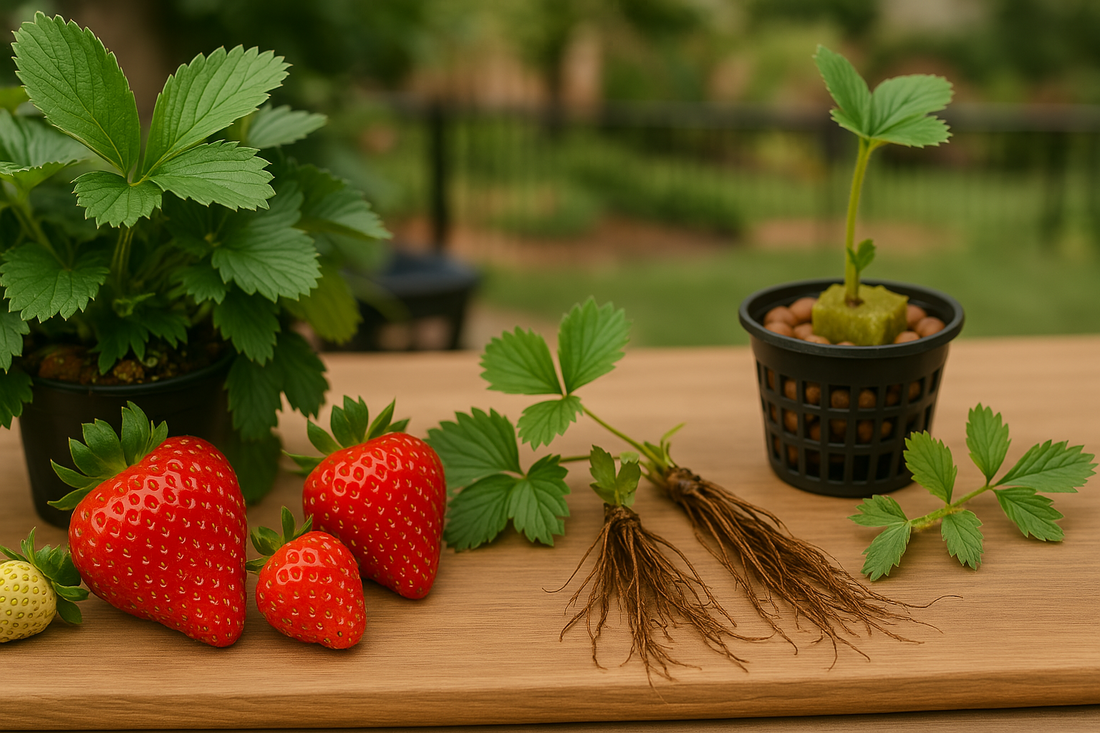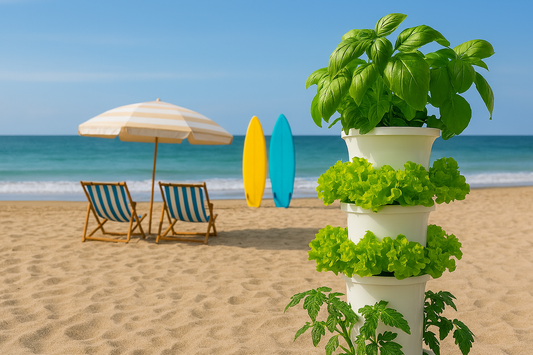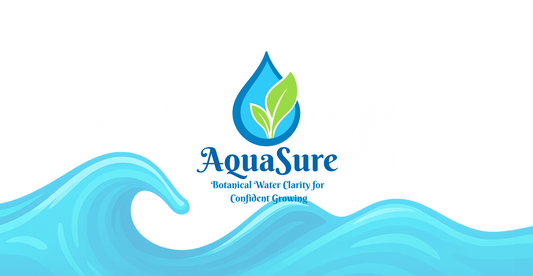
The Complete Guide to Growing Strawberries Hydroponically
Introduction
Strawberries thrive in hydroponic systems, offering growers faster production, cleaner fruit, and controlled nutrition. With the right setup, big, juicy strawberries can be produced year-round without soil-related diseases or unpredictable growing conditions.
Anatomy of a Strawberry Plant
Understanding strawberry plant anatomy is key to effective pruning and care, ensuring optimal growth and yield. Each part plays a role in plant health and fruit production:

- Crown – The heart of the plant where stems and roots meet; should always remain above the growing medium to prevent rot.
- Leaves – Essential for photosynthesis; trimming excess foliage allows energy to be redirected toward fruit production.
- Runners – Long stems that produce new plants; prune them unless propagation is the goal.
- Roots – Vital for nutrient uptake; ensure proper aeration and drainage to avoid root rot.
- Flowers & Fruits – Flowers develop into strawberries; ensuring adequate pollination maximizes fruit yield.
A strong grasp of these structures aids in maintaining healthy plants and optimizing growth.
Choosing the Right Strawberry Variety
One of the most important decisions in hydroponic strawberry cultivation is choosing the right variety. While all strawberries share similar growth patterns, some perform significantly better in soil-free environments. Everbearing and day-neutral varieties are ideal because they produce fruit continuously rather than cycling through a single harvest.
Recommended Varieties for Hydroponics:

- Albion – High yield, large fruit, resistant to common diseases.
- Seascape – Sweet flavor, excellent hydroponic adaptability.
- Mara des Bois – French variety with strong aroma and flavor.
- San Andreas – Vigorous plants with consistent fruit production.
Choosing a day-neutral variety ensures continuous flowering and fruit set, maximizing yield potential.
Obtaining & Preparing Your Plant

Seed or Bare Root?
For home hydroponic systems, bare root plants are highly recommended over seeds. They establish faster, are hardier against transplant shock, and produce fruit within the first growing season. Seeds, on the other hand, require significantly more time to reach maturity, making them a less viable option for efficient hydroponic setups.
Bare Root Preparation & Quarantine
Starting strawberries from bare roots ensures a strong foundation, but improper handling can introduce pests and diseases into the hydroponic system. Proper preparation prevents setbacks before they occur.
Rehydration Steps:
Before sanitization, rehydrate the bare root plants to prepare them for nutrient absorption:
Submerge the entire plant in clean, room-temperature water for 1-2 hours. This restores moisture, making them more resilient for the next steps.
Sanitization Methods:
Bare root plants can carry pests or diseases that could jeopardize your hydroponic system. Proper sanitation eliminates potential threats, ensuring your plants start in a clean, controlled environment.
Of the three methods below, hypochlorous acid (HOCl) is the safest and most effective option, providing strong disinfection without harming the plant. Bleach and hydrogen peroxide are viable alternatives, but must be precisely diluted—incorrect concentrations can damage root tissues or disrupt beneficial microbes.
For more indepth details on safely sanitizing your grow systems and environment. Another one of our comprehensive guides will be available soon.
Sanitization Steps:
⚠️WARNING: Chose one of these methods but DO NOT mix them. Mixing an acid with an akaline can result in deadly chlorine gas.

- HOCl Solution – If you're using HOCl created with a Force of Nature (FON) appliance, there is no need to dilute the concentration. You can simply rinse the plant in the water for about 10 minutes. However, if you're using a mixture where your ppm is > 200ppm (using Chlroine test strips) or your ORP is >750mV(using an ORP capable meter), then it needs to be diluted. Simply Mix 50 mL of hypochlorous acid with 450 mL of clean water.
- Bleach Solution – Mix 50 mL of bleach with 450 mL of water. Soak for 10 minutes, then rinse thoroughly.Be very careful with your dilution. A mistake here can damage or even kill your plant.
- Hydrogen Peroxide Solution – Mix 1 part 3% hydrogen peroxide with 2 parts water. Soak for 10 minutes, then rinse thoroughly.Be very careful with your dilution. A mistake here can damage or even kill your plant.
Rockwool & Hydroton Setup for Bare Root Plants

Some growers opt for hydroton (expanded clay pebbles) as their main growing medium, but when planting bare-root strawberries, rockwool provides superior initial support. It maintains moisture, stabilizes the root system, and prevents transplant stress better than loose pebbles alone.
Best Practice: A Hybrid Approach Rather than using only hydroton, place hydroton underneath and around (space allowing) the rockwool for added support.
- Slice a rockwool cube in half.
- Spread the roots evenly, ensuring they don’t bunch together.
- Position the crown above the surface to prevent rot.
- Surround the rockwool with hydroton in the net cup or yCube—this improves drainage and prevents root suffocation.
- Quarantine for 1-2 weeks, feeding with diluted Veg+Bloom solution to encourage stable early growth.
Optimizing Nutrient Management
Many growers assume that if their strawberries look healthy, their nutrient mix must be working. But unseen fluctuations in pH and unstable formulations can quietly sabotage fruit production, leading to weak yields and nutrient deficiencies. Stable nutrients prevent these issues, ensuring strawberries get consistent feeding without hidden stressors.
Using Veg+Bloom or VBX ensures consistent, stable nutrient delivery, eliminating errors from unstable formulations.
Why Avoid Unstable Nutrients?
Liquid nutrients and DIY formulations (like Masterblend) create inconsistencies in nutrient ratios, causing fluctuations in EC and plant stress. Pre-blended solutions prevent errors, ensuring even feeding cycles.
Shine: Maximizing Flowering & Fruit Set
During the bloom phase, strawberries demand additional phosphorus and potassium to drive flower production and fruit formation. Shine enhances this process by:
- Boosting flower set – More flowers = more fruit potential.
- Enhancing sugar accumulation – Producing sweeter, better-quality strawberries.
- Improving fruit size & uniformity – Eliminating inconsistencies in berry development.
Environmental Control for Maximum Yield
VPD Management
Many growers focus on nutrients and light but underestimate the impact of humidity on strawberry growth. Too much moisture invites fungal diseases, while dry conditions stress the plants, leading to weak fruit development. Maintaining the right Vapor Pressure Deficit (VPD)—between 0.8 and 1.2 kPa—ensures optimal moisture balance, preventing issues before they arise.
PPFD Optimization
Light intensity is a powerful tool in hydroponic strawberry cultivation, but improper adjustments can result in weak, underdeveloped fruit. By carefully managing Photosynthetic Photon Flux Density (PPFD)—starting at 250-400 µmol/m²/s for vegetative growth and increasing to 400-600 µmol/m²/s during flowering—growers can promote strong, high-yielding plants.
PPFD is easily managed with meters like this one. Simple to use and make adjustments. This is another key to successful growing.
Pest Management

Few things can disrupt a thriving hydroponic system faster than a spider mite outbreak. These tiny pests thrive in dry conditions, silently weakening plants until the damage is irreversible. A proactive approach to pest control, proper quarantine methods, VPD management, using neem oil, beneficial mites, and preventative sprays, keeps strawberries healthy and pest-free.
Take these in steps and only go to the next step if the first step doesn't work. The other steps will usually be completely unnecessary if you follow the propper treatments and quarantine step.
🍓 Strawberry Growing Guide: EC Levels & Irrigation Timing (Hydroponic Towers & Flood & Drain Systems)
| Growth Stage | EC Range (mS/cm) | Water Time ON / OFF | Notes |
|---|---|---|---|
| Seedling / Establishment | 1.0 – 1.4 | ON 15 min / OFF 45 min (daytime only) | Gentle cycle supports root development without nutrient stress |
| Vegetative Growth | 1.4 – 1.8 | ON 15–20 min / OFF 40–60 min | Promotes foliage and consistent root-zone hydration |
| Flowering & Fruiting | 1.8 – 2.2 | ON 20 min / OFF 40 min | Higher nutrient demand—ensure cycles meet water uptake rates |
| Peak Production | 2.0 – 2.5 | ON 20–30 min / OFF 30–45 min | Responsive cycle helps maintain fruit turgor & prevent tip burn |
| Maximum Tolerable | Up to 3.0 | Adjust ON/OFF based on plant cues & drainage EC | Monitor carefully—salt accumulation can impair yield |
🌱 Pro Tips
- System Target: This irrigation timing is optimized for hydroponic towers and flood & drain setups.
- Cycle Tuning: Adjust ON/OFF intervals based on climate, crop stage, and tank temperature.
- Root Zone Monitoring: Use media sensors or EC probes to fine-tune intervals if needed.
- pH Range: Maintain between 5.5 and 6.5 for ideal nutrient uptake.
- Drainage EC: If runoff exceeds 1.2 mS/cm, flush to prevent salt buildup.
- Irrigation Method: Avoid overhead watering—use drip rings or base fill for towers to reduce fungal risk.
- Overwatering Signs: Watch for wilting, yellowing, or algae growth near roots.
Conclusion
Hydroponic strawberries offer faster growth, bigger yields, and disease prevention compared to traditional soil cultivation. By choosing the right varieties, preparing bare roots properly, using stable nutrients like Veg+Bloom, VBX and Shine, and controlling environmental factors, growers can produce consistently large, flavorful strawberries year-round.






